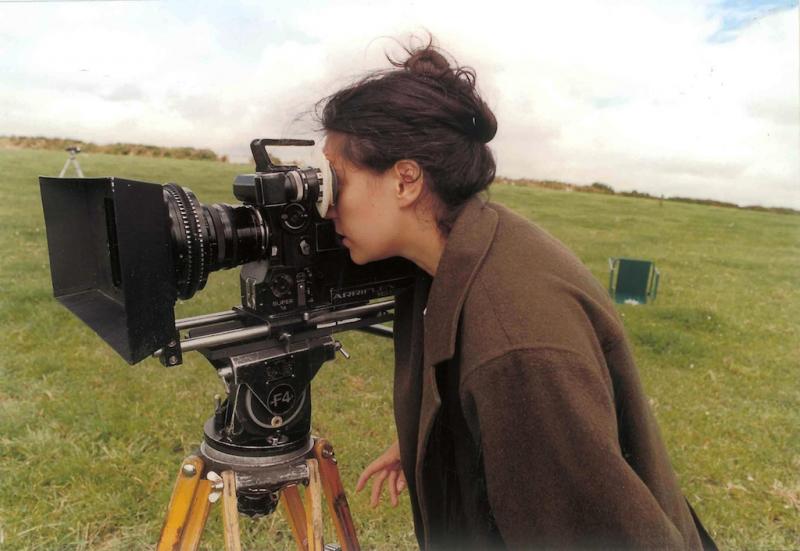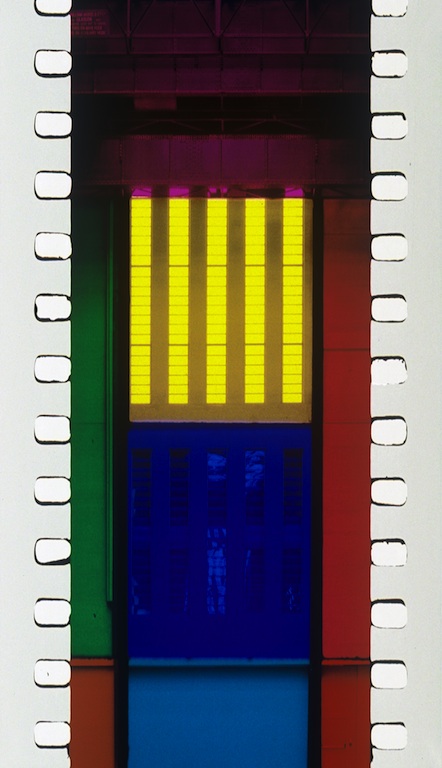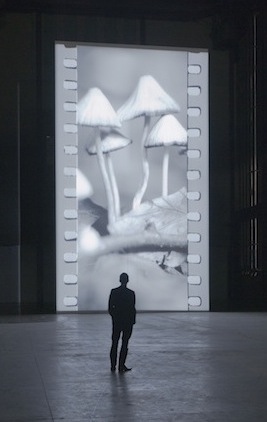Tacita Dean, FILM, Tate Modern | reviews, news & interviews
Tacita Dean, FILM, Tate Modern
Tacita Dean, FILM, Tate Modern
A visual collage that pays homage to the beauties of fast-disappearing analogue film

Tate Modern’s lofty Turbine Hall is dominated by a giant CinemaScope screen flipped on its side so it becomes 42ft high and resembles a lift shaft or cathedral window. Instead of angels, saints or sinners, though, the starring role in Tacita Dean’s FILM is given to the building’s east window – the one hidden behind the huge screen. One of the main subjects of the film, then, is the very spot where you are standing – where much of the film was shot.
On film, the familiar glass and steel structure plays host to images culled from the outside world such as fountains, waterfalls, lakes, the sea, trees, a smoking industrial chimney, an escalator, flowers, mushrooms, pigeons, a snail and a grasshopper; add to this abstract patterns and surreal incursions such as an eye, balloons and a light bulb, and you get an apparently random sequence of mesmerising visual effects lasting just 11 minutes.
 "FILM (pictured right and below) is basically a collage," Dean explains and she means it literally. The images took shape as collages made by cutting up postcards from her vast collection; she surrounded the Matterhorn with sea, for instance and, on screen, the idea is transformed into a peak rising above swirling mist.
"FILM (pictured right and below) is basically a collage," Dean explains and she means it literally. The images took shape as collages made by cutting up postcards from her vast collection; she surrounded the Matterhorn with sea, for instance and, on screen, the idea is transformed into a peak rising above swirling mist.
Making a collage with scissors and glue is one thing, but producing similar effects on celluloid without resorting to post-production wizardry is a huge challenge. To introduce the variously shaped inserts she wanted, Dean had to design circular, elliptical, square and triangular masks that fitted between the film and lens to conceal some parts of the frame and expose the rest. And to construct each frame one element at a time meant putting the film through the camera up to 10 times.
She also revived techniques such as glass matte painting; to mimic lightning, she painted a jagged line across glass and shone a light through it. Hand-tinting turned black-and-white footage blue, orange, cerise or pink and allowed an eight-second shot of mushrooms to appear in six different colours. Finally, down the side of each frame she added sprocket marks so that on screen the image looks like a strip of film held up to the light. Not surprisingly she describes FILM as a portrait of film that pays homage to the medium.
"FILM," she writes, “is a visual poem. I found the rhythms and metre from the material itself, relying not only on the images I had but on what is normally considered waste: the picture fading at the end of a roll, the shimmering metamorphosis of a filter change and the flash frames of over-exposure as the camera stops and starts. FILM is about film and in the end I let the material’s intrinsic magic be my guide.”
As you might have guessed, Dean is in love with film; ever since studying at the Slade School of Fine Art in the early 1990s, she has been working with celluloid. The timing of FILM is crucial, since the medium is rapidly becoming obsolete. As digital replaces analogue, labs are closing all over Europe and technical expertise is disappearing fast; it will soon be impossible to get analogue footage processed and printed.
 For most film-makers switching to digital is an easy option but if, like Dean, you love celluloid and choose to spend hours in your studio editing on an old-fashioned, reel-to-reel Steinbeck, loss of physical contact with the material is a devastating prospect. “We must fight to keep a foothold on Mount Analogue," she writes, “or risk a colossal depletion of irretrievable knowledge and skill, as well as the experience and history of over a hundred years of film and photographs made on film.”
For most film-makers switching to digital is an easy option but if, like Dean, you love celluloid and choose to spend hours in your studio editing on an old-fashioned, reel-to-reel Steinbeck, loss of physical contact with the material is a devastating prospect. “We must fight to keep a foothold on Mount Analogue," she writes, “or risk a colossal depletion of irretrievable knowledge and skill, as well as the experience and history of over a hundred years of film and photographs made on film.”
One of the things she loves about celluloid is that you never know exactly what you are getting so you have to rely on your wits and editing skills to pull everything together. But editing FILM proved more hair-raising than anticipated. At the 11th hour things in the editing suite in Amsterdam went horribly wrong.
Used to editing 16mm, Dean encountered problems working with 35mm, which led to unwelcome flashes of white randomly appearing on the screen. Help came in the form of Steve Farman from Professional Negative Cutting Ltd who drove to Holland with his equipment, worked day and night to rescue the edit and delivered the cans to Tate Modern just two days before the opening. Even for Dean, who insists that “I don’t like to know where I’m going”, that is cutting it a bit fine,
You don’t have to be a film buff to enjoy FILM; encountering a kaleidoscope of images and abstract patterns on such a vast scale is a powerful experience. The mood varies from dreamy, contemplative and elegiac to surreal.
Some images, such as a fountain, tree or sunlight filtering through leaves, fill the entire screen and, since the film is silent, such moments assume an almost religious intensity. Tate Modern has often been referred to as a cathedral of culture and, in this context, the east window assumes the significance of the east window of an actual cathedral; in some shots, a cathedral window even replaces parts of the industrial structure.
 Some images have a liminal surreality; giant bubbles float dreamily down through the space – an ostrich egg nestles on a window ledge or grows so enormous it fills the entire hall; an eye gazes out at us from on high. Others are humorous; a red mountain peak (pictured right: detail) pays ironic homage to the Paramount Picture logo and an orange disk floating above an abstracted landscape evokes the giant sun by Olafur Eliasson (with whom Dean shares a studio in Berlin), which a few years ago bathed the Turbine Hall in orange light.
Some images have a liminal surreality; giant bubbles float dreamily down through the space – an ostrich egg nestles on a window ledge or grows so enormous it fills the entire hall; an eye gazes out at us from on high. Others are humorous; a red mountain peak (pictured right: detail) pays ironic homage to the Paramount Picture logo and an orange disk floating above an abstracted landscape evokes the giant sun by Olafur Eliasson (with whom Dean shares a studio in Berlin), which a few years ago bathed the Turbine Hall in orange light.
Most often, though, Mondrian is the artist who comes to mind as shimmering colours irradiate various sections of the grid-like structure. This is film treated as painting, and asked what she might do if it became impossible to work with analogue film any longer, Dean replied that she might go back to painting or might become a writer.
In the book accompanying the exhibition she and luminaries such as Jeff Wall, Neil Young, Jean-Luc Godard, Martin Scorsese and Steven Spielberg write eloquently about the special qualities of the medium that will be lost for ever if it is allowed to disappear.
- Tacita Dean: FILM at Tate Modern until 11 March, 2012
Buy
Explore topics
Share this article
The future of Arts Journalism
You can stop theartsdesk.com closing!
We urgently need financing to survive. Our fundraising drive has thus far raised £49,000 but we need to reach £100,000 or we will be forced to close. Please contribute here: https://gofund.me/c3f6033d
And if you can forward this information to anyone who might assist, we’d be grateful.

Subscribe to theartsdesk.com
Thank you for continuing to read our work on theartsdesk.com. For unlimited access to every article in its entirety, including our archive of more than 15,000 pieces, we're asking for £5 per month or £40 per year. We feel it's a very good deal, and hope you do too.
To take a subscription now simply click here.
And if you're looking for that extra gift for a friend or family member, why not treat them to a theartsdesk.com gift subscription?
more Visual arts
 'We are bowled over!' Thank you for your messages of love and support
Much-appreciated words of commendation from readers and the cultural community
'We are bowled over!' Thank you for your messages of love and support
Much-appreciated words of commendation from readers and the cultural community
 Folkestone Triennial 2025 - landscape, seascape, art lovers' escape
Locally rooted festival brings home many but not all global concerns
Folkestone Triennial 2025 - landscape, seascape, art lovers' escape
Locally rooted festival brings home many but not all global concerns
 Sir Brian Clarke (1953-2025) - a personal tribute
Remembering an artist with a gift for the transcendent
Sir Brian Clarke (1953-2025) - a personal tribute
Remembering an artist with a gift for the transcendent
 Emily Kam Kngwarray, Tate Modern review - glimpses of another world
Pictures that are an affirmation of belonging
Emily Kam Kngwarray, Tate Modern review - glimpses of another world
Pictures that are an affirmation of belonging
 Kiefer / Van Gogh, Royal Academy review - a pairing of opposites
Small scale intensity meets large scale melodrama
Kiefer / Van Gogh, Royal Academy review - a pairing of opposites
Small scale intensity meets large scale melodrama
 Jenny Saville: The Anatomy of Painting, National Portrait Gallery review - a protégé losing her way
A brilliant painter in search of a worthwhile subject
Jenny Saville: The Anatomy of Painting, National Portrait Gallery review - a protégé losing her way
A brilliant painter in search of a worthwhile subject
 Abstract Erotic, Courtauld Gallery review - sculpture that is sensuous, funny and subversive
Testing the boundaries of good taste, and winning
Abstract Erotic, Courtauld Gallery review - sculpture that is sensuous, funny and subversive
Testing the boundaries of good taste, and winning
 Edward Burra, Tate Britain review - watercolour made mainstream
Social satire with a nasty bite
Edward Burra, Tate Britain review - watercolour made mainstream
Social satire with a nasty bite
 Ithell Colquhoun, Tate Britain review - revelations of a weird and wonderful world
Emanations from the unconscious
Ithell Colquhoun, Tate Britain review - revelations of a weird and wonderful world
Emanations from the unconscious
 Rachel Jones: Gated Canyons, Dulwich Picture Gallery review - teeth with a real bite
Mouths have never looked so good
Rachel Jones: Gated Canyons, Dulwich Picture Gallery review - teeth with a real bite
Mouths have never looked so good
 Yoshitomo Nara, Hayward Gallery review - sickeningly cute kids
How to make millions out of kitsch
Yoshitomo Nara, Hayward Gallery review - sickeningly cute kids
How to make millions out of kitsch
 Hamad Butt: Apprehensions, Whitechapel Gallery review - cool, calm and potentially lethal
The YBA who didn’t have time to become a household name
Hamad Butt: Apprehensions, Whitechapel Gallery review - cool, calm and potentially lethal
The YBA who didn’t have time to become a household name

Add comment